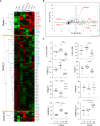Identification of natural killer markers associated with fatal outcome in COVID-19 patients
- PMID: 37342247
- PMCID: PMC10277643
- DOI: 10.3389/fcimb.2023.1165756
Identification of natural killer markers associated with fatal outcome in COVID-19 patients
Abstract
Introduction: Increasing evidence has shown that coronavirus disease 19 (COVID-19) severity is driven by a dysregulated immunological response. Previous studies have demonstrated that natural killer (NK) cell dysfunction underpins severe illness in COVID-19 patients, but have lacked an in-depth analysis of NK cell markers as a driver of death in the most critically ill patients.
Methods: We enrolled 50 non-vaccinated hospitalized patients infected with the initial virus or the alpha variant of SARS-CoV-2 with moderate or severe illness, to evaluate phenotypic and functional features of NK cells.
Results: Here, we show that, consistent with previous studies, evolution NK cells from COVID-19 patients are more activated, with the decreased activation of natural cytotoxicity receptors and impaired cytotoxicity and IFN-γ production, in association with disease regardless of the SARS-CoV-2 strain. Fatality was observed in 6 of 17 patients with severe disease; NK cells from all of these patients displayed a peculiar phenotype of an activated memory-like phenotype associated with massive TNF-α production.
Discussion: These data suggest that fatal COVID-19 infection is driven by an uncoordinated inflammatory response in part mediated by a specific subset of activated NK cells.
Keywords: COVID-19; SARS-CoV-2 infection; fatal outcome; natural killer (Nk) cell; tNF-alpha.
Copyright © 2023 Tarantino, Litvinova, Samri, Soulié, Morin, Rousseau, Dorgham, Parizot, Bonduelle, Beurton, Miyara, Ghillani, Mayaux, Lhote, Lacorte, Marcelin, Amoura, Luyt, Gorochov, Guihot and Vieillard.
Conflict of interest statement
The authors declare that the research was conducted in the absence of any commercial or financial relationships that could be construed as a potential conflict of interest.
Figures





Similar articles
-
Difference in Lymphocyte Subset Counts According to Disease Severity and SARS-CoV-2 Variants of Hospitalized COVID-19 Patients in Korea.J Korean Med Sci. 2025 Jul 28;40(29):e172. doi: 10.3346/jkms.2025.40.e172. J Korean Med Sci. 2025. PMID: 40726240 Free PMC article.
-
Antibody tests for identification of current and past infection with SARS-CoV-2.Cochrane Database Syst Rev. 2022 Nov 17;11(11):CD013652. doi: 10.1002/14651858.CD013652.pub2. Cochrane Database Syst Rev. 2022. PMID: 36394900 Free PMC article.
-
SARS-CoV-2-neutralising monoclonal antibodies for treatment of COVID-19.Cochrane Database Syst Rev. 2021 Sep 2;9(9):CD013825. doi: 10.1002/14651858.CD013825.pub2. Cochrane Database Syst Rev. 2021. PMID: 34473343 Free PMC article.
-
SARS-CoV-2-neutralising monoclonal antibodies to prevent COVID-19.Cochrane Database Syst Rev. 2022 Jun 17;6(6):CD014945. doi: 10.1002/14651858.CD014945.pub2. Cochrane Database Syst Rev. 2022. PMID: 35713300 Free PMC article.
-
Natural Killer Cell Receptors and Ligands Are Associated With Markers of HIV-1 Persistence in Chronically Infected ART Suppressed Patients.Front Cell Infect Microbiol. 2022 Feb 10;12:757846. doi: 10.3389/fcimb.2022.757846. eCollection 2022. Front Cell Infect Microbiol. 2022. PMID: 35223535 Free PMC article.
Cited by
-
Natural killer (NK) cells in bipolar disorders.Neurosci Appl. 2024 Apr 11;3:104066. doi: 10.1016/j.nsa.2024.104066. eCollection 2024. Neurosci Appl. 2024. PMID: 40656111 Free PMC article. Review.
-
Elevated levels of cell-free NKG2D-ligands modulate NKG2D surface expression and compromise NK cell function in severe COVID-19 disease.Front Immunol. 2024 Feb 12;15:1273942. doi: 10.3389/fimmu.2024.1273942. eCollection 2024. Front Immunol. 2024. PMID: 38410511 Free PMC article.
-
Investigation of HLA-B -21 M/T Dimorphism and Its Potential Role in COVID-19.Int J Mol Sci. 2025 Jul 3;26(13):6419. doi: 10.3390/ijms26136419. Int J Mol Sci. 2025. PMID: 40650195 Free PMC article.
References
-
- Béziat V., Liu L. L., Malmberg J. A., Ivarsson M. A., Sohlberg E., Björklund A. T., et al. . (2013). NK cell responses to cytomegalovirus infection lead to stable imprints in the human KIR repertoire and involve activating KIRs. Blood 121 (14), 2678–2688. doi: 10.1182/blood-2012-10-459545 - DOI - PMC - PubMed
Publication types
MeSH terms
Substances
LinkOut - more resources
Full Text Sources
Medical
Miscellaneous

